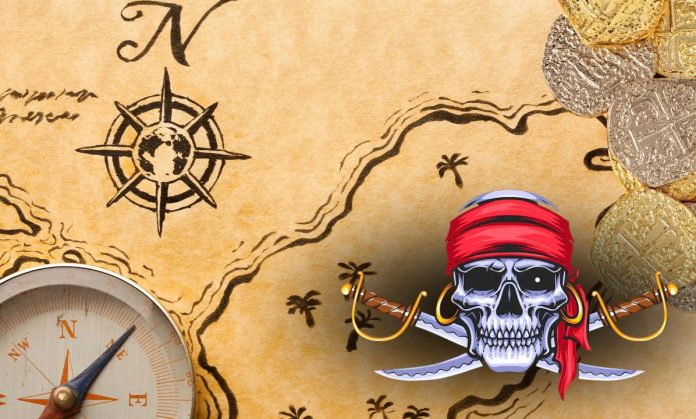Pirates – the very word conjures images of eye patches, skull and crossbones flags, and high-seas adventures. Yet, the history of piracy stretches back over 3000 years, with its origins shrouded in the mists of time. To understand the genesis of piracy, one must look into the annals of history, exploring the evolution of the term and the socio-economic conditions that gave rise to these seafaring outlaws.
Early Origins of Piracy
The term “pirate” finds its roots in ancient literature, with mentions dating back to Homer’s epic poems, The Iliad and The Odyssey. However, it wasn’t until the Roman historian Polybius and the Greek scholar Plutarch that piracy was formally defined. From the Norse Vikings of the 9th and 11th centuries to the medieval “sea thieves” of England, piracy took on various forms throughout history.
The 16th century heralded the dawn of the Age of Exploration, a period marked by colonial expansion and burgeoning maritime trade. With the advent of better, faster ships, piracy gained prominence, fueled by the competing interests of colonial powers. The Barbary Coast, a notorious haven for pirates in North Africa, became a symbol of lawlessness on the high seas.
Why did pirates become pirates?
On the social and economic front, England was facing social upheaval and economic disparity which drove many to seek fortune and freedom on the open sea. Displaced farmers and struggling tradesmen flocked to coastal towns, where piracy offered a tantalising opportunity for wealth and autonomy.
In an age when few people travelled and young men might have to work seven-year apprenticeships before making an independent living, many were tempted to go to sea anyway, though life was tough.
Adolescents who longed to escape could get a job on a sailing ship before they were fully grown: agility was needed as much as brute strength.
Yet ordinary seamen toiled for modest wages and were subject to strict discipline. In contrast, piracy not only offered them a chance to get rich quickly but also a rare opportunity to exert a degree of power over others.
The Different Types of Pirates
Corsairs were pirates who operated in the Mediterranean Sea between the 15th and 18th centuries. Muslim corsairs, such as the Barbarossa brothers, had bases along North Africa’s Barbary Coast, while Christian corsairs were based on the island of Malta. Both used to swoop down on their targets in oar-powered boats called galleys, to carry off sailors and passengers. Unless these unfortunates were rich enough to pay a ransom, they were sold as slaves.
Then there were the Buccaneers, who lived on the Caribbean island of Hispaniola and its tiny turtle-shaped neighbour, Tortuga, in the 17th century. At first, they lived as hunters, but later the governors of Caribbean islands paid the buccaneers to attack Spanish treasure ships. Although raids began in this way, with official backing, the buccaneers gradually became out of control, attacking any ship they thought carried valuable cargo, whether it belonged to an enemy country or not. The buccaneers had become true pirates.
Finally, Privateers, were privately owned (rather than navy-owned) ships armed with guns, operating in times of war. The Admiralty issued them with ‘letters of marque’ that allowed them to capture merchant vessels without being charged with piracy, which essentially meant that they were licensed by the government to loot.
Piracy in Pop Culture
The allure of pirates has captivated imaginations for centuries, inspiring countless tales of swashbuckling adventure. From classic literature to blockbuster films like “Pirates of the Caribbean,” pirates have become iconic figures in popular culture. Every Halloween, revellers don pirate costumes, paying homage to these legendary rogues of the sea. Let’s face it, who doesn’t want to be Captain Jack Sparrow?
While piracy may seem like a relic of the past, its legacy endures in maritime law, literature, and society. Modern-day piracy continues to pose challenges to global security and commerce, reminding us of the enduring allure of the high seas. As we navigate the waters of history, let us remember the pirates who once ruled the waves and the lessons they teach us about freedom, adventure, and the human spirit.
In fact, the relevance of pirates still soars today, in 2024, despite the decline witnessed in piracy off the coast of Somalia. While the tactics and motivations may differ, the spectre of maritime insecurity persists. Attacks by Somali raiders, which began in the 1990s and intensified post-2006 due to the country’s descent into chaos, underscored the vulnerability of international shipping. Although piracy peaked around 2012, concerted efforts by a coalition of international navies, coupled with costly self-protection measures and legal actions against pirates, managed to quell the menace to a significant extent.
However, in the present day, new actors like the Houthis have emerged, utilizing advanced technologies such as drones, missiles, and speedboats to target ships. Their motivations, rooted in regional conflicts rather than economic gain, present a different challenge altogether. Thus, while the tactics may evolve and the perpetrators may change, the threat to maritime security persists, necessitating ongoing vigilance and collaborative efforts to safeguard international waters.
As we bid farewell to our swashbuckling journey through the annals of piracy, one thing remains clear – the legacy of pirates lives on. From the ancient marauders of the Mediterranean to the buccaneers of the Caribbean, piracy has left an indelible mark on history and popular culture alike. So, the next time you hear the call of the sea, remember the pirates who came before us, daring to defy the odds and chart their own course across the vast expanse of the ocean.





























